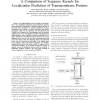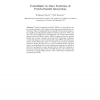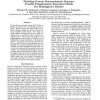2666 search results - page 160 / 534 » Computing with Evolving Proteins |
RECOMB
2006
Springer
15 years 10 months ago
2006
Springer
In this paper, we present CONTRAlign, an extensible and fully automatic framework for parameter learning and protein pairwise sequence alignment using pair conditional random field...
CIBCB
2007
IEEE
15 years 4 months ago
2007
IEEE
Abstract— We applied Support Vector Machines to the prediction of the subcellular localization of transmembrane proteins, and compared the performance of different sequence kerne...
GECCO
2007
Springer
15 years 4 months ago
2007
Springer
In this paper, a model based on genetic algorithms for protein folding prediction is proposed. The most important features of the proposed approach are: i) Heuristic secondary str...
RECOMB
2005
Springer
15 years 3 months ago
2005
Springer
Abstract. Peptide recognition modules (PRMs) are specialised compact protein domains that mediate many important protein-protein interactions. They are responsible for the assembly...
ISMB
1998
14 years 11 months ago
1998
Wedescribe a prototype system (Poly-X) for assisting an expert user in modelingprotein repeats. Poly-X reduces the large numberof degrees of freedomrequired to specify a protein m...



